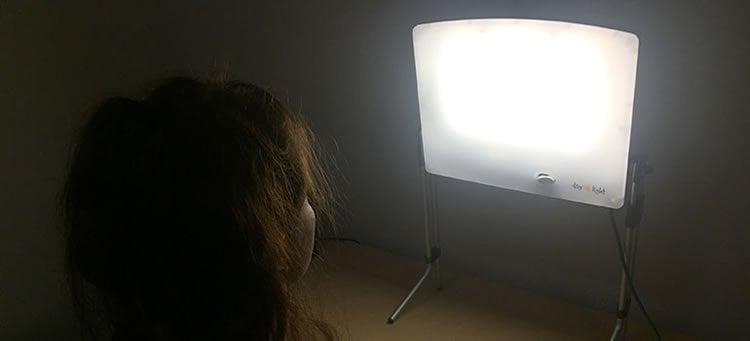New research finds that light therapy can treat non-seasonal depression and improve the overall wellbeing of people suffering from the disease.
“These results are very exciting because light therapy is inexpensive, easy to access and use, and comes with few side effects,” said Dr. Raymond Lam, a UBC professor and psychiatrist at the Djavad Mowafaghian Centre for Brain Health, a partnership between UBC and Vancouver Coastal Health. “Patients can easily use light therapy along with other treatments such as antidepressants and psychotherapy.”
The research, published today in JAMA Psychiatry, is the first placebo-controlled trial that shows that light therapy is an effective treatment for depression that is not brought on by seasonal affective disorder.
Lam and his colleagues followed 122 patients and evaluated whether light therapy improved the mood of patients when it was used both with and without the commonly prescribed antidepressant fluoxetine. Light therapy involved 30 minutes of exposure to a fluorescent light box soon after waking up every day for eight weeks. Some study participants were given placebo pills and placebo devices instead of the real therapies. The researchers found that light therapy helped many patients and provided the most benefit to those who were also taking antidepressants.
Depression affects one in 20 people and is among the leading causes of disability worldwide. Depression can cause significant problems in family and personal relationships, work attendance and productivity, and overall quality of life. It is also associated with an increased risk of death.
According to the researchers, medications are effective for treating depression but only work in about 60 per cent of cases.

“More and more people are seeking help because there is less stigma about having depression,” said Lam. “It’s important to find new treatments because our current therapies don’t work for everyone. Our findings should help to improve the lives of people with depression.”
Funding: This research was funded by the Canadian Institutes of Health Research (CIHR) and involved patients from Vancouver, Toronto, Calgary and Saint John.
Source: University of British Columbia
Image Credit: The image is adapted from the University of British Columbia press release.
Original Research: Full open access research for “Efficacy of Bright Light Treatment, Fluoxetine, and the Combination in Patients With Nonseasonal Major Depressive Disorder” by Raymond W. Lam, MD; Anthony J. Levitt, MBBS; Robert D. Levitan, MD, MSc; Erin E. Michalak, PhD; Rachel Morehouse, MD; Rajamannar Ramasubbu, MD; Lakshmi N. Yatham, MBBS, MBA; and Edwin M. Tam, MDCM in JAMA Psychiatry. Published online November 18 2015 doi:10.1001/jamapsychiatry.2015.2235
Abstract
Efficacy of Bright Light Treatment, Fluoxetine, and the Combination in Patients With Nonseasonal Major Depressive Disorder
Importance Bright light therapy is an evidence-based treatment for seasonal depression, but there is limited evidence for its efficacy in nonseasonal major depressive disorder (MDD).
Objective To determine the efficacy of light treatment, in monotherapy and in combination with fluoxetine hydrochloride, compared with a sham-placebo condition in adults with nonseasonal MDD.
Design, Setting, and Participants Randomized, double-blind, placebo- and sham-controlled, 8-week trial in adults (aged 19-60 years) with MDD of at least moderate severity in outpatient psychiatry clinics in academic medical centers. Data were collected from October 7, 2009, to March 11, 2014. Analysis was based on modified intent to treat (randomized patients with ≥1 follow-up rating).
Interventions Patients were randomly assigned to (1) light monotherapy (active 10 000-lux fluorescent white light box for 30 min/d in the early morning plus placebo pill); (2) antidepressant monotherapy (inactive negative ion generator for 30 min/d plus fluoxetine hydrochloride, 20 mg/d); (3) combination light and antidepressant; or (4) placebo (inactive negative ion generator plus placebo pill).
Main Outcomes and Measures Change score on the Montgomery-Åsberg Depression Rating Scale (MADRS) from baseline to the 8-week end point. Secondary outcomes included response (≥50% reduction in MADRS score) and remission (MADRS score ≤10 at end point).
Results A total of 122 patients were randomized (light monotherapy, 32; fluoxetine monotherapy, 31; combination therapy, 29; placebo, 30). The mean (SD) changes in MADRS score for the light, fluoxetine, combination, and placebo groups were 13.4 (7.5), 8.8 (9.9), 16.9 (9.2), and 6.5 (9.6), respectively. The combination (effect size [d] = 1.11; 95% CI, 0.54 to 1.64) and light monotherapy (d = 0.80; 95% CI, 0.28 to 1.31) were significantly superior to placebo in the MADRS change score, but fluoxetine monotherapy (d = 0.24; 95% CI, −0.27 to 0.74) was not superior to placebo. For the respective placebo, fluoxetine, light, and combination groups at the end point, response was achieved by 10 (33.3%), 9 (29.0%), 16 (50.0%), and 22 (75.9%) and remission was achieved by 9 (30.0%), 6 (19.4%), 14 (43.8%), and 17 (58.6%). Combination therapy was superior to placebo in MADRS response (β = 1.70; df = 1; P = .005) and remission (β = 1.33; df = 1; P = .02), with numbers needed to treat of 2.4 (95% CI, 1.6 to 5.8) and 3.5 (95% CI, 2.0 to 29.9), respectively. All treatments were generally well tolerated, with few significant differences in treatment-emergent adverse events.
Conclusions and Relevance Bright light treatment, both as monotherapy and in combination with fluoxetine, was efficacious and well tolerated in the treatment of adults with nonseasonal MDD. The combination treatment had the most consistent effects.
“Efficacy of Bright Light Treatment, Fluoxetine, and the Combination in Patients With Nonseasonal Major Depressive Disorder” by Raymond W. Lam, MD; Anthony J. Levitt, MBBS; Robert D. Levitan, MD, MSc; Erin E. Michalak, PhD; Rachel Morehouse, MD; Rajamannar Ramasubbu, MD; Lakshmi N. Yatham, MBBS, MBA; and Edwin M. Tam, MDCM in JAMA Psychiatry. Published online November 18 2015 doi:10.1001/jamapsychiatry.2015.2235







